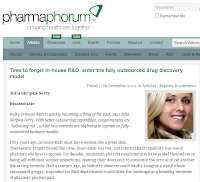It is China month here at Bioassociate, and in our previous post on China we covered some of the new initiatives filed in the latest set of 5-year plans aimed at making China a competitor in the originator pharma space.
One such initiative has been the direction of foreign investment towards niches which the government has deemed "innovative". Needless to mention, pharma and biotech are high priority on the list of said niches.
Another issue which the government has prioritized (for very obvious reasons) is the intellectual property protection situation in the country. Historically, China has been one of the most notorious violators in the IP space, but perhaps all of that is about to change over the next decade.
Direction of Foreign Investment
The Chinese government has specified rules on the direction of foreign investment in order to nurture certain
priority sectors and to restrict investment in others. China’s foreign
investment policy is outlined in the Regulations for Guiding the Direction of
Foreign Investment, which essentially classifies foreign investment into one of
four classes: encouraged projects, permitted projects, restricted projects and
prohibited projects.
As of 2009, investment in innovative pharma
falls under the category of encouraged projects, specifically the production of
raw pharmaceuticals which are under patent, those which are granted administrative
protection in China, and products which use new technologies. Investment in
generic APIs and traditional Chinese medicines is currently restricted, in
order to direct investment towards the innovative sector.
In a step to improve investment opportunities
for its innovative industries, the Chinese government launched ChiNext on the
Shenzhen Stock Exchange—China’s “NASDAQ”—in 2009, paying particular attention
to innovative enterprises and supporting venture entities. ChiNext is expected to play a crucial role in
innovation by providing an important exit alternative for many start-ups over
the coming years. The independent exchange caters to the high-growth, high-tech
sector, and the majority of its 354 listed companies are SMEs with a combined
market value of roughly US$ 118 billion. Currently, 24 companies are listed in the
Pharmaceutical Industry on the ChiNext, 9 of which were listed in the last year
(see table 1).
Table 1. 24 Pharmaceutical companies listed on the ChiNext (as of Oct.
2012)
- TickerCompany NameListing DateMarket Cap. (CNY bn.)300006CHONGQING LUMMY30/10/20093.37300009ANHUI ANKE BIOTECHNOLOGY30/10/20092.37300016BEILU PHARMA30/10/20092.05300026CHASE SUN PHARM.30/10/20097.55300039SHANGHAI KAIBAO08/01/20106.50300049INNER MONGOLIA FREE MEDICAL TECH.20/01/20101.59300086HAINAN HONZ26/05/20102.65300110QINGDAO HUAREN PHARM.25/08/20103.09300119TIANJIN RINGPU BIOTECH.17/09/20103.28300122CHONGQING ZHIFEI-BIOLOGICAL PROD.28/09/201012.6300138CHENGUANG BIOTECH05/11/20101.67300142WALVAX BIOTECH12/11/20106.73300147XIANGXUE PHARM.15/12/20103.55300158SHANXI ZHENDONG PHARM07/01/20112.74300181ZHEJIANG JOLLY PHARM22/02/20112.02300194CHONGQING FUAN PHARM22/03/20112.66300199HYBIO PHARM07/04/20113.10300204STAIDSON BIOPHARM15/04/20116.24300239BAOTOU DONGBAO BIOTECH06/07/20111.80300254SHANGXI C&Y PHARMACEUTICAL19/08/20111.16300255HEBEI CHANGSHAN BIOCHEM.19/08/20112.17300267HUNAN ER-KANG PHARM27/09/20114.33300289BEIJING LEADMAN BIOCHEM16/02/20123.52
Note: There is substantial discrepancy between Market Cap values contained
in the ChiNext company index found on the official Shenzhen Stock Exchange
website, and values found on leading financial data websites. The official
ChiNext company index can be found here: http://www.szse.cn/main/en/marketdata/sinformation/index.shtml?CATALOGID=1693&TABKEY=tab4
Intellectual Property Protection
Historically, China has had a skeptical
approach towards IP protection, as it was viewed as a hindrance to the
country’s imitation- and manufacturing-driven economy. Before 1992, patent
protection was virtually non-existent, and between 1992 and 2008 pharmaceutical
patents could essentially be violated on a “me-too” basis, where minor
structural differences from existing drugs would suffice for marketing
approval. In 2008 China became the newest entrant to the intellectual property
arena, having finally adopted comprehensive patent protection regulations. Since
then, the protection system strengthened significantly, albeit not sufficiently,
and, despite the new initiatives, the IP protection arena remains in need of
improvement. Current regulations still exclude IP protection of medical
treatments, which encompass drug delivery, medical devices and personalized
medicine.
Along with remaining regulatory concerns and
loopholes, IP implementation is a pressing issue, particularly
due to lack of adequate enforcement procedures in place, and due to insufficient
numbers of enforcement authorities throughout the country whose pharmaceutical
industry is highly geographically fragmented. In 2009, US businesses lost a colossal US$ 48 billion in sales,
royalties and licensing fees due to patent infringement by Chinese
manufacturers.
In a recent move to act on this issue, the
Supreme People’s Court of China (SPC) has set up two judicial IP protection
bodies to act on behalf of the innovative pharmaceutical industry. The
government is additionally making an effort to engage with industry
representatives and foreign authorities in order to progress necessary
amendments in the IP system. A positive increase in numbers of IPR cases in
recent years showcases the government’s efforts, and, because the government is
able to draw on established legal environments, it is a matter of time before a
sufficiently operational IP protection system is in place.
China’s
strengthening IP protection regulations will certainly be an addition to the
plethora of factors which will serve to buttress the innovative pharma industry
over the next decade.














